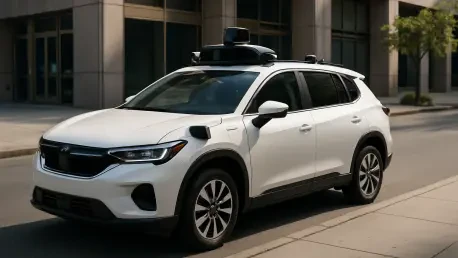What if a morning commute could predict your needs before you even voice them, transforming the way you start your day? Picture this: hopping into a ride and receiving a notification for a discounted coffee just as hunger strikes, or gliding through city streets in a driverless car that feels like something out of a sci-fi movie. Uber is turning these scenarios into reality, leveraging artificial intelligence and autonomous vehicles to transform not just transportation, but the entire rhythm of daily life. This journey into cutting-edge technology promises to reshape urban mobility in ways that demand attention.
The significance of Uber’s push into AI and robo-cabs cannot be overstated. As urban populations swell and the demand for seamless, efficient services skyrockets, the company stands at the forefront of a mobility revolution. With fewer than one in five users currently engaging with both its rideshare and delivery platforms, Uber sees a golden opportunity to boost loyalty and revenue. This isn’t merely a corporate strategy—it’s a bold step toward redefining how millions navigate their world, blending convenience with innovation on an unprecedented scale.
Why Uber’s Tech Leap Is a Game-Changer
In today’s fast-paced environment, convenience reigns supreme, and Uber is under immense pressure to differentiate itself in a crowded market. The integration of rideshare and delivery services through AI-driven personalization addresses a critical gap: cross-platform engagement. Data reveals that users who interact with both services show over 35% higher retention rates and generate three times the bookings compared to single-service users. This statistic underscores the potential for technology to bind customers closer to the platform.
Beyond immediate business gains, Uber’s focus on autonomous vehicles taps into a global race to master self-driving technology. Testing in cities like Austin and Atlanta has shown promising results, with Waymo-powered robo-cabs completing more daily trips than 99% of human drivers. This isn’t just about replacing drivers—it’s about crafting a future where urban travel is safer, more efficient, and endlessly adaptable to user needs.
The broader impact of these advancements touches on societal trends as well. As cities grapple with traffic congestion and environmental concerns, autonomous rides could reduce human error and carbon footprints. Uber’s vision aligns with a growing appetite for tech-savvy solutions, positioning the company as a leader in shaping how urban lifestyles evolve over the coming years.
Unpacking Uber’s Bold Strategies for Transformation
At the heart of Uber’s reinvention are two powerful pillars: AI for hyper-personalization and the deployment of robo-cabs. The first strategy uses sophisticated algorithms to deliver tailored offers, such as a discounted latte during a morning ride, timed perfectly to boost user engagement. This cross-promotion between rideshare and Uber Eats isn’t random—it’s a calculated move to create seamless experiences that keep users within the ecosystem.
The second pillar, autonomous vehicles, is generating excitement despite being far from profitable. In test markets, these driverless cars are not only operational but also outperforming most human drivers in trip volume, creating a buzz that enhances the platform’s appeal. While still in early development, this initiative signals a commitment to long-term innovation, even if the financial returns remain on the horizon.
These strategies are interconnected, aiming to build a cohesive tech-driven platform. The personalization efforts are described as being in the “second inning” of a longer game, suggesting plenty of room for refinement. Meanwhile, robo-cabs serve as a symbol of what’s possible, inspiring confidence in Uber’s ability to adapt and lead in a rapidly changing industry.
Hearing from the Innovators and Users
Leadership at Uber is candid about the ambitions and challenges of this tech pivot. CEO Dara Khosrowshahi has emphasized the goal of creating “magical experiences” through AI, ensuring offers feel intuitive rather than invasive. This balance is critical, as personalization must enhance user trust rather than erode it, a point that shapes the company’s cautious approach to data use.
On the financial side, CFO Prashanth Mahendra-Rajah provides a grounded perspective, noting that investments in unprofitable areas like robo-cabs are part of a deliberate strategy to build scale first. With a reported net income of $1.35 billion on $12.65 billion in revenue for the latest quarter, Uber demonstrates fiscal strength, yet profit margins lag behind typical tech standards, highlighting the need for these risky bets to pay off eventually.
User reactions add another layer to the story. In Atlanta, a rider described a driverless trip as a thrilling novelty, turning a routine commute into a memorable event. Such feedback illustrates the emotional impact of innovation, reinforcing why Uber continues to push boundaries despite the steep costs and uncertainties involved.
Navigating the Benefits of Uber’s New Era
For those eager to experience Uber’s evolving offerings, there are tangible ways to get involved. Start by using both the rideshare and delivery services on the app to access personalized promotions—think meal discounts synced with travel times. Keeping an eye on app notifications ensures no tailored deal slips through the cracks, maximizing convenience.
In cities where robo-cabs are being tested, such as Austin, opting into a driverless ride offers a firsthand look at the future of mobility. Staying updated on Uber’s announcements can help identify when and where these services expand. Engaging with these innovations not only enhances daily routines but also provides valuable input that could influence how the technology develops.
Beyond individual use, consider the wider implications of AI in everyday life. Personalized offers might soon predict needs across various platforms, while autonomous vehicles could redefine urban planning. Embracing these changes early positions users to adapt to a world where technology increasingly anticipates and meets personal demands.
Reflecting on Uber’s Journey and What Lies Ahead
Looking back, Uber’s strides in blending AI with autonomous technology marked a pivotal chapter in urban mobility. The fusion of personalized offers and driverless rides showcased a vision that went beyond mere transportation, aiming to weave convenience into the fabric of daily existence. Each step, from early robo-cab trials to refined algorithms, built a foundation for something transformative.
The road ahead invites active participation. Exploring cross-platform services and testing new features can help shape the direction of these tools, ensuring they align with real user needs. As Uber continues to navigate financial challenges and scale innovations, the collective input of its community becomes a vital force in driving progress.
Ultimately, the legacy of this era rests on a simple idetechnology should serve people, not just systems. Staying curious about emerging solutions and advocating for balanced, user-focused advancements remains essential. The story of redefining rides is one that everyone can help write, step by innovative step.









